Tureen
Unidentified artist
Transcription
Geir Thomas Risåsen
It is an amazing item. And, it is clear that it also shows that people in the 18th century had a sense of humour…
Narrator
This soup tureen has traveled all the way from the porcelain workshops in China, to a Norwegian dinner table sometime in the 18th century. But not just to any random dinner table, says curator Geir Thomas Risåsen at the Norwegian Folk Museum.
Geir Thomas Risåsen
This is something that belongs in the wealthy, bourgeois homes and among the upper class in society.. And it is clear that, those who could afford it, could really afford it. They could order their porcelain from China! This terrine is an example of that.
Narrator
This terrine would have been brought out for a dinner party. Maybe a Christmas party. When you really want to impress your guests. Picture this: the chandelier is lit, a white damask cloth is on the table, and it is set with the house's finest tableware in blue, white and gold. The servants bring in dish after dish of the most delicious food.
And then suddenly this howling pig head appears!
Geir Thomas Risåsen
Beautifully glazed in shades of grey. And with a red muzzle and a violet tongue sticking out.
Narrator
People like to call this type of imaginative tableware "conversation pieces" - a kind of conversation starter.
If the conversation was a bit slow around the table, then you could talk a bit about China, or pigs, or perhaps preferably about what was inside the terrine.
Geir Thomas Risåsen
And this terrine, I think, has probably been used for a type of ragout. Ragout is fried or boiled meat served in a spicy sauce. So maybe there was a pork ragout that you would serve…
Ragout, is a French word that means to whet the appetite. And I definitely want to say that the food served in this terrine, whets my appetite!